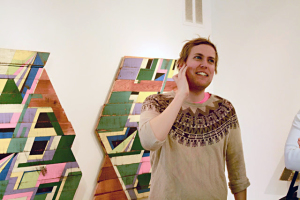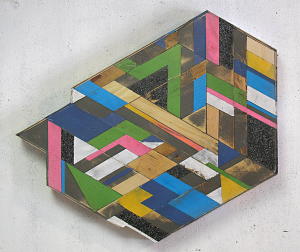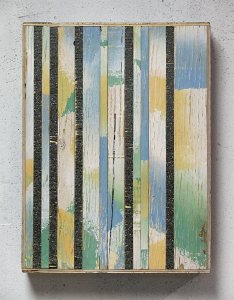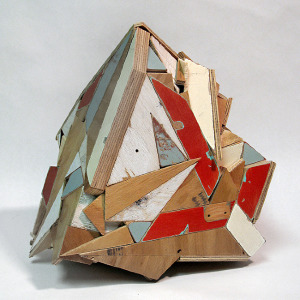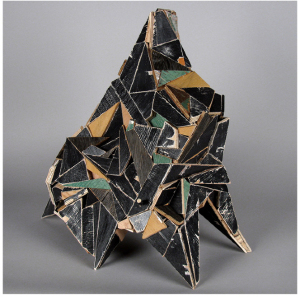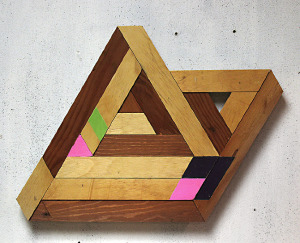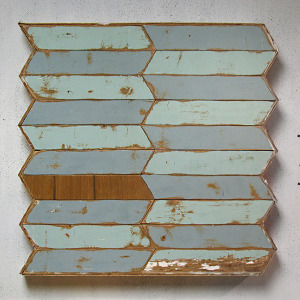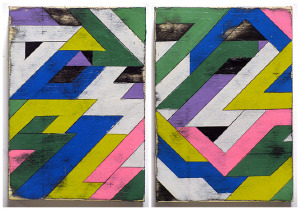A Conversation with Artist Aaron Moran
A few years ago I took an extension class at the SF Art Institute about creating art from scrap. The truth is I took the class so I could spend more time in the concrete complex, which I love. One of my life regrets is that I didn’t pursue fine art and the SF Art Institute might have been the right place in the late 1970s. In the class I made a couple of three-dimensional sculptures out of scraps that I found. Now everywhere I turn I see litter and garbage I want to transform into small collages. But I worry about the germs.
Aaron Moran isn’t so fearful. He finds art in the waste of building sites near his home outside Vancouver where old houses have been torn down to make way for new condos. A few weeks ago I was posting images in my Art file on Pinterest and came across works by this artist I had never heard of. I tracked Aaron down and we had the following conversation via email.
Did you study artists who liked hard-edged geometric forms like (early) Frank Stella or Kenneth Noland? Did Joseph Cornell influence you in terms of reusing the discards of society?
Frank Stella was definitely someone whose work I have always remembered and admired, but I wouldn’t say I’m influenced by him. Joseph Cornell, not so much, but an artist who also worked with assemblage boxes similar to him who really did influence my work was Karl Fred Dahmen.
What was it about Dahmen’s work that influenced you?
I only stumbled across his work about the time I was in art school, but his assemblages and use of found materials were very intriguing. I loved how he created compositions out of materials regarded as waste (in many case, literally taken from junk yards).
Can you talk about other artists who were important to you growing up?
When I was younger, I enjoyed surrealism, for example Magritte and Dali, but I don’t necessarily see any connection between them and my current practice.
Do you think of your work as based in place? I understand that a lot of the raw material is detritus from sites where homes have been torn down. But is it accidentally about Vancouver and Langley, British Columbia?
The work is certainly about place. It is no accident that the pieces reference the locations they come from. Many of my earlier works are actually named after the addresses where the materials were found. I find a lot of importance in the context of the work—where it’s made, where it’s exhibited, etc. By working in Langley, I feel that the work acts as a primary source regarding the current development practices of the location.
Do you still live in Langley?
I recently moved about 15 minutes east to Surrey, British Columbia, which is experiencing similar developments, but is much further along. Instead of building town homes and condos as in Langley, they are building high-rises and sprawling multilevel malls.
What inspired you move from flat collage to more three-dimensional sculptures?
Actually, it happened the other way around—I began with three-dimensional works and eventually started creating flat ones when I was running low on material and experimenting with painting. Because the material is found, there is only so much of it available to use, so it happened out of necessity more than anything.
Have you continued to pursue larger works?
I have had a hard time working large, mainly because of limited studio space and limited space to store it once it’s complete. I hope to have the opportunity to work large or explore installations while pursuing my MFA.
Did you take shop in high school? Or did you learn to work the equipment in college?
I did take shop in high school, but only for about two years—truth be told, I was quite afraid of certain power tools. My dad has a small woodworking shop, so my confidence with working on the equipment came from experimenting and playing around throughout the years. While I have been successful creating sculptures, I am a poor carpenter.
What did you do in the one-year residency that was different from your regular life? Was it like a sabbatical from your paying job? How did it change your work?
I remained working during the residency (at a nearby university). More than anything, it gave me space and time and removed distractions. I was about 1 hour and 45 minutes from Langley, living alone with nobody nearby. It gave me the time to experiment around the clock, and while I don’t love every piece I created while there, it was responsible for creating a steppingstone for the work I create now.
Do you typically drive around the city looking for scraps?
I walk a lot, so if I find pieces small enough to carry, I pick them up while I’m out. If I find a stash that is too difficult to walk with, I will make note of it and come back with a car to pick it all up.
What is the weirdest thing you ever found?
Weird, but not too uncommon, are the belongings of people who seem to have left their properties in a hurry. Things like personally recorded VHS tapes, kids’ dolls or toys, even a photo album now and then.
A recent blog post suggested you were working with new wood and paint. Is this a different direction?
The wood, while it may appear new, is in fact gathered from bins that are designated as shop waste from several shops around town. I think this hits home the idea that people are throwing away perfectly good material without thinking of its possibilities. The use of painting is something I am exploring, but more in a way to emphasize the materials I found to begin with.
Do you use glue to hold your pieces together? Or nails? Or both?
I use a high-melting-point hot glue and air nails when necessary. Wood glue does not set fast enough for the way I work.
You’ve mentioned the phrase “organized chaos” before. In a video of one of your lectures, there were pictures of your three-dimensional sculptures underneath a photograph of the lot where you found some of the debris that went into the piece. Do the piles influence the shape of your three-dimensional work?
Absolutely—I think more than anything they reference the jagged piles of material from where they came. Also just the chaotic mess left behind by developers who bulldoze everything into unorganized piles. I try to organize them into something aesthetically pleasing.
Are your pieces like a frozen memento of what was lost?
I think that is the best way to put it. They are pieces made from structures of a different time that have been removed and forgotten about by the time something new is built where it once stood.
Does faith play a role in your work?
No.
When you are in a work groove, do you think of that time as spiritual in some way?
Not in any religious sense, but I get a natural high when I am on a roll—I feel incredibly energized. It is my time to myself, and it’s exciting to see what I can do with it.
Does anybody ever throw you off their land for trespassing?
I don’t jump fences or take material from construction lots—I only go on lots that have been abandoned for long periods of time. The worst I’ve had was a security guard asking what I was doing and asking me to leave. It’s easy enough, however, to come back at a later time.
Do you work on several pieces at one time, moving back and forth?
I always work on several pieces at a time, that way I can jump back and forth if I find pieces of material that would work better in a certain situation. Also, when I get frustrated with one piece, I can move on to another until I’m ready to come back to it.
Are you embracing social media as a way to share your art, your sensibility?
I used to have a Tumblr account, but I found it insufficient for creating a professional-looking portfolio. I don’t use Facebook for my art.
I found a number of videos about your work. Is that a medium you want to explore further?
Definitely not—in these cases, I feel that the video worked more as documentation than anything else.
Are you still thinking about pursuing a master’s degree?
I will be beginning my MFA studies this September at the University of Windsor in Ontario.
Why did you choose the University of Windsor?
I’m very interested in the Windsor/Detroit region because of its history as a “failed” manufacturing district. From my research, it seems that entire neighborhoods have turned into ghost towns. I suppose I see the area as a microcosm of the overlying development issues that I explore now.
Given how much your work has been shaped by your immediate environs, how do you think Ontario might influence your work?
I feel like the themes I explore are readily available in that region, just on a much larger scale. Windsor has a far more developed history that Langley, so I can’t help but think that my work will resonate with the place.
All images courtesy aaronsmoran.com.
